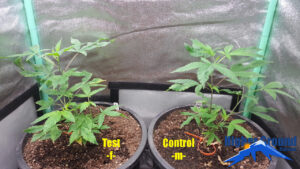THE FOOP is a commercially available nutrient supplement for Cannabis cultivation and is made from (you guessed it) fish poop. As a consultant for Medical Marijuana (MMJ) patients growing in their homes, I thought it would be interesting to make things easier and try bottled nutrients (if I could find a well-researched program).
One frustration I have with consulting for more than one home-grower at a time is the need to keep numerous organic supplies on hand in each location. Until recently, each location was required to keep several organic nutrient supplements in bottles, powders, salts and other amendments for instant use if anything should need adjustment.
When I came across The FOOP, I discovered one of their prime selling points, the number of solutions to manage, would be only five. With only a need for pH adjustment, the total number of bottles I’d have to manage at each location would total seven (7) – not bad. The FOOP is produced in a two-part vegetative growth formula (Veg 1 and Veg 2), a two-part flowering formula (Bloom 1 and Bloom 2), and a concentrated sweetener made of several sugars easily absorbed and used by plants in the peak of flower when they need additional energy to meet high metabolic needs. Dilutions are easy, thanks to FOOP preparing the source solutions so that users add equal amounts of each to a water volume and adjust pH.
First Trial
One problem home growers face is wasted time – namely time spent without the full number of plants legally allowed to be in their possession. In Washington state, qualifying MMJ patients may possess up to fifteen plants to provide for their needs. Therefore, they don’t have the luxury of maintaining a steady supply of clones in various stages of growth, and must plan a flower cycle with extreme care. If vegetation time can be reduced, less plants will need to be maintained in a vegetative state at any given time. Growers on an ‘every two weeks’ schedule may keep six plants in vegetation and eight in bloom, while still maintaining a single mother plant. This works well for patients consuming (or at least growing) only one variety. For those requiring more varieties, one plant every other week can yield as much as two in the right conditions. [See HigherGround420 methods]
Procedure
Two Blue Dream clones were selected for a side-by-side vegetative growth test. One “Ready to Flower” (RTF) clone would be selected from these. Both plants were in the same early stage of growth, were vigorously growing, and both had about the same number of leaves, branches and biomass, and were later contained in identical five-gallon, black plastic pots with drip pans [see photos below].
Both plants were grown under one light (LED, 300w) placed evenly between and above the two. Distance to the light, the Canopy Distance, was identical. The test plant (f) was given FOOP according to the manufacturer’s dilution instructions, while the control plant (m) was fed according to usual protocols, which included Fish and Kelp emulsion, Epsom salts, compost, compost tea, worm castings, beneficial fungi and aerobic bacteria. Both protocols were administered twice weekly, with pH always adjusted to approximately 6.5.
Results
After six weeks of 24-hour lighting, the test plant (FOOP) was visually estimated to have 30- to 50% more plant biomass than the standard organic protocol, and was 100% RTF, whereas the control required another two weeks to reach the same visually estimated biomass [see photos]. At eight weeks, the test plant remained fuller, and impressively more vibrant than the control. At its most basic level, the FOOP would save my clients two weeks of pre-flower care by reducing vegetation time by 25% (from 8 weeks to just 6).
Analysis
Discussion
Reduced vegetation time doesn’t free up one’s veg tent for an extra harvest, but reduces the number of work days per plant. Gardens flowering two new plants every two weeks may not observe time savings, but may observe that the veg tent’s canopy becomes fuller faster, and therefore may require more pruning and training, or more space for slightly larger plants.
Commercial growers and home growers living in places not constrained by plant count will find that Cannabis yield is truly limited by canopy area. However, preliminary trials suggest yields will rival the very best of previous grow cycles. Simple comparison with past harvests suggests FOOP provides freshly renewed ideal nutrition at all stages of the plant’s life cycle.
Flower comparison was attempted, but was not documented as one plant became infested with mites and would therefore skew results. The next trial may compare yields, costs and flower quality produced with FOOP versus a very simple purchase of fresh, commercially available soil (Fox Farm – ocean forest). This trial may compare a plant grown in fresh soil to one grown in spent soil supplemented with FOOP.
Acknowledgments: Jeff Cole offers SEATTLE BLISS consulting services to home growers living in any legal environment and welcomes HigherGround420 subscribers to request private consultation via email at [email protected].
FOOP Organic Biosciences (Silver Springs, Maryland) provided a product sample for evaluation, and had no affiliation with HigherGround420 during this production. However, everyone is free to join and support HigherGround420. Clicking the link below doesn’t benefit HG420, but lets FOOP know you’re glad they provided product for this test. If you’d like to see more, be sure to buy yours after clicking below to save 10% on your order.
Scroll To Top





